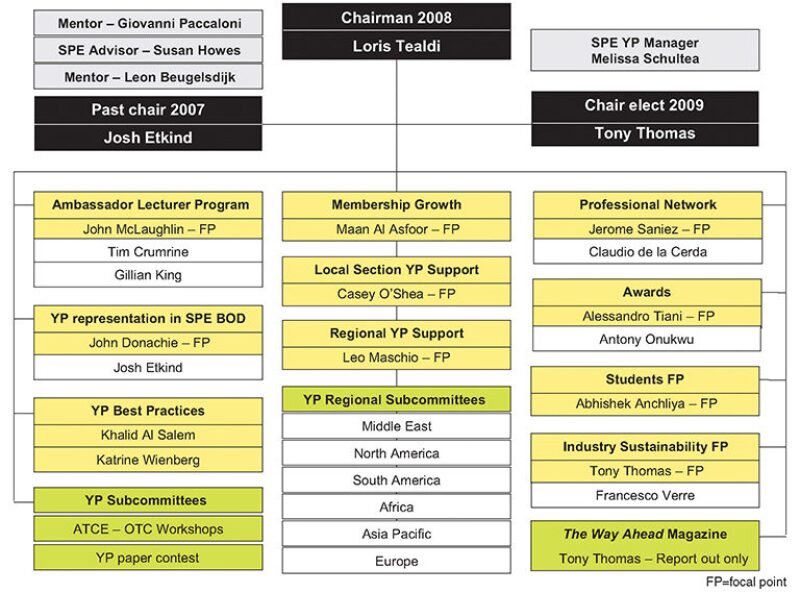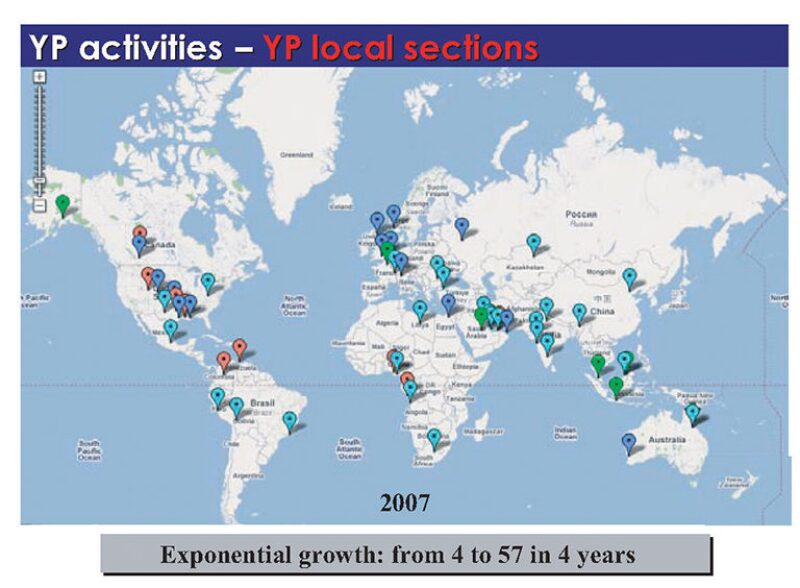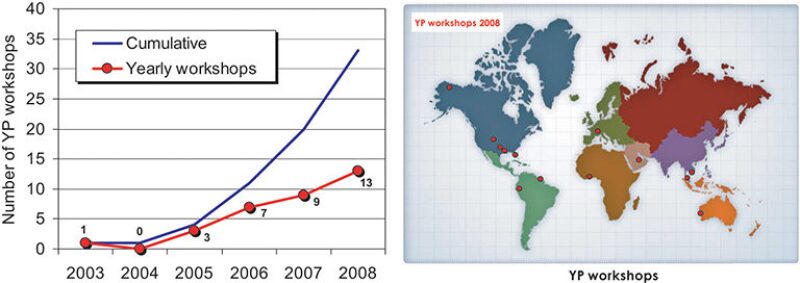SPE young professionals (YPs) are fuelling our industry with fresh energy. The effects are evident.
Since the last ATCE in Anaheim, California in November 2007, I have had the honor to chair the Young Professionals Coordinating Committee (YPCC), a strong team of 18 highly capable individuals selected with care within the community for their leadership skills and motivation. Diversity in company affiliation, work location, nationality, and gender were crucial in the selection process. Within the YPCC, members are divided by roles and group of activities (Fig. 1).
In an epoch characterized by demographics skewed toward retirement age and a sunset industry image that fails to attract top-notch technical graduates, YPs represent the most important asset of today’s companies. We are trying to offer opportunities for development to all the future leaders of an industry that will face increasing challenges to meet ever-expanding energy demand from a finite resource that is more and more difficult and expensive to find, develop, and deliver. In the above, you find the main mission of the YPCC.
Since 2005, when the YPCC was founded under the supervision of the 2005 SPE President Giovanni Paccaloni, the number of activities worldwide by and for YPs has shown great growth. Thanks to the commitment of the previous chairpersons Leon Beugelsdijk (2006) and Josh Etkind (2007) and their teams, the service that SPE can offer to YPs today is really impressive and variegate. Let me introduce to you some of our activities and achievements.
SPE YP Local Sections
Following the four pioneer YP sections (Italy, Aberdeen, The Netherlands, and Gulf Coast), the number of YP sections has exploded in the past 4 years, approaching 60 at the end of 2007 (Fig. 2). The process of growth is continuous especially in regions like South America, Asia Pacific, and Middle East.
To all YP chairpersons worldwide: A new international award has been approved to reward the best SPE YP sections worldwide annually at each ATCE. The enthusiasm, innovation, and commitment of your local section may be rewarded at the next ATCE in Denver (September 2008).
Young Professionals Network (YPN)
The worldwide YPN allows young members to discuss career issues, ideas, events, and best practices for sustaining SPE and the industry. The YPN represents the opportunity for any SPE YP to be part of a worldwide community to share experiences and knowledge, download useful material for their own development or for their local sections, and become updated on all the activities ongoing all over the globe. Through the network, YPs function as an international team, maximizing the impact of local initiatives while also creating international events to serve the needs of today's young, global member. I invite you to make a visit, you will like it! You will find useful links to all our activities at www.spe.org/spe-app/spe/groups/yps/index.htm.
The Way Ahead Magazine
It is the most visible activity of SPE Young Professionals. It offers discussions on a large variety of themes all relevant to the YPs’ and students’ development as future leaders of this industry. Since the first edition in 2005, 11 issues have been published and distributed to around 20,000 members among YPs and a selected pool of top executives. The magazine represents our vehicle to disseminate knowledge and to inform all YPs worldwide of our activities and services and of existing opportunities for self-development. The magazine is also available online at www.spe.org/spe-app/spe/twa/index.htm.
Ambassador Lecturer Program
The Ambassador Lecturer Program (ALP), links YPs with students by means of presentations in universities with the aim of helping students gain insight into the next generation of workers and thus be better prepared to enter the workforce. This initiative was started in 2005–06 with a pilot project of 12 visits to universities in Europe and North America. After the success of the 30 visits of 2007, in 2008, we are planning around 50 visits with more focus in new areas like Africa, Asia Pacific, South America, and the Middle East.
YP Best Practices
To make YP programs self-propelling, we are trying to develop best practices to help YPs around the globe start their local sections, become Ambassador Lecturers, to host and organize an international YP workshop, write SPE papers, attract members, and much more. Interesting insights can be found in the YPN.
YP International Workshops
Since the first workshop in Stresa, Italy (2003), the number of international workshops organized by YPs has grown significantly to a cumulative total of around 30 so far. Fig. 4a shows the continuous growth of international events. The 2008 ATW program is well distributed around the various regions worldwide (Fig. 4b).
Awards
We take care of the motivation of our members. A source of motivation is recognition.
To recognize our best YPs, awards are given at the international, regional, and local section level. They give visibility to YPs who excel through service in the community (International and Regional Young Member Outstanding Service Awards; YP of the Year Award) or through their technical contributions (Ferguson Medal). In addition to the current set of awards, two new initiatives have been recently introduced:
- Outstanding Section YP Program (to be awarded each year at the ATCE)
- International YP SPE paper contest (to be awarded each year at the ATCE)
You can find more information about all the existing YP awards online in the YPN.
Membership Growth
Thanks to the new initiatives and the enthusiasm around the globe, more and more YPs are joining SPE and are discovering the mutual benefits of being part of this community. In the last 5 years, the SPE YP population has increased by 57% and that is expected to increase further when students active in their SPE chapters join the industry (Fig. 5a). Areas such as Africa, South America, and the Middle East represent the regions where we are concentrating most of our membership efforts. It may be a coincidence, but since the YPCC was founded and YP activities exploded, the average SPE member age has started decreasing (Fig. 5b). This is a great trend because we are replenishing retiring seniors with energetic professionals, offering a bright future to the industry.
Bridging the Students to our Industry
As previously discussed when describing the ALP initiatives, YPs should act as bridges between the students and the industry. The number of student chapters increased from 80 to more than 170 in the last 10 years. This means that there is a tremendous potential for membership growth, new and fresh ideas and energy in the universities. In this perspective, a new function has just been added in the YPCC structure: Students. Our objective is to develop activities and practices to facilitate the conversion from SPE sudent to SPE YP member and to offer new services to help this transition.
Other Interesting Activities
- Industry sustainability: How can we make the YP programs self-propelling? What are the challenges that the industry will face and the actions we need to take today to be ready in the future?
- Environment, people, and finite resources: How can we find the optimum synergy? The sustainability team within the YPCC is dealing with these issues with articles on these subjects and by providing precious insights through the YPCC.
- www.Energy4me.org: Addressing the education of the younger generation.
- eMentoring: www.spe.org/spe-app/spe/career/ementor/index.htm
- YP e-Newsletter: A newsletter sent to all members to describe the ongoing YP activities worldwide.
Thanks to the energy and volunteerism of YPs worldwide, we are doing a great job and continuously growing together in this great learning experience that is SPE. I am confident that our commitment will have a strong impact on the quality, professionalism, and motivation of the next generation of leaders of the oil and gas business. A great thanks to all who are already active and proactive members of SPE and who contribute to fuel our world with energy and help us to make a difference.
For any question, or to offer you to volunteer in some of our local, regional, or, international activities, please do not hesitate to contact our SPE YP Program Manager, Melissa Schultea, at mshultea@spe.org.
- Fig. 1—The SPE Young Professionals Coordinating Committee 2008.
- Fig. 2—Locations of YP local sections at the end of 2007.
- Fig. 4—a) The growing interest in YP international workshops b) The geographical coverage of SPE ATWs in 2008.
- Fig. 5—a) SPE membership evolution, b) SPE “nonstudent” membership average age evolution with time.





